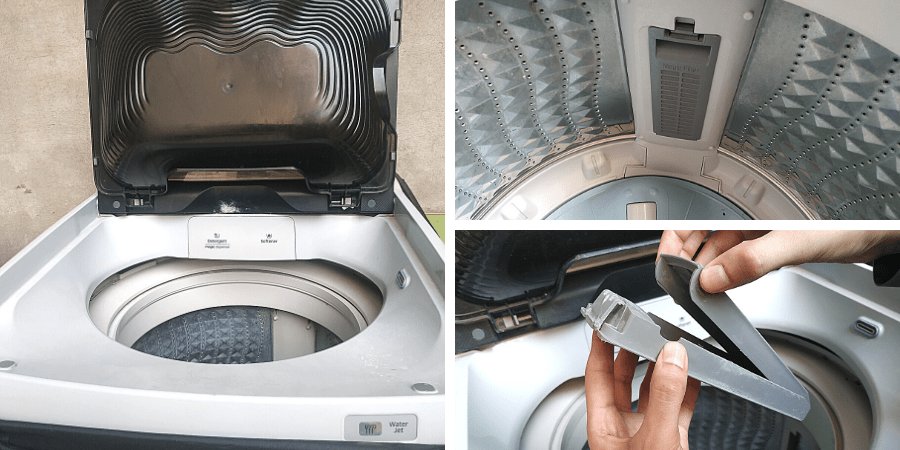Table of Contents
Last Updated on: 1st July 2023, 07:00 pm
Do you have a leaking washing machine? It can be challenging to diagnose since you may not detect the problem right away.
Maybe, the water appears from the front of the washer while the leak is around the rear. Therefore, it’s essential to keep an eye on washing machine leaks, especially if you have an indoor laundry area.
Most washing machine leaks are minor, anyway. It doesn’t mean you should keep your guard down. It’s also true that you may be able to repair them yourself; it’d be saving you the trouble, time, and money of hiring a professional.
| Disclaimer: As an Amazon Associate, I earn from qualifying purchases. |
This tutorial describes the most typical indicators of washing machine leaks, the likely causes, and how to repair them.
So if you have a washing machine like most of us, then you should keep reading this piece.
Before we get to the other possibilities or solutions to this problem, there are a few things you should do right away if your washing machine is leaking:
- Switch off your washing machine in the first step.
- Disconnect your washing machine from the main power.
- Ensure that your washing machine is level.
- Ensure that all faucets are turned off.
There are various possible causes of your washing machine leaking.

Here are some recommendations to deal with the washing machine leak:
Examine the water supply connection to the washing machine
Examine the connection to your washing machine’s water supply. Sometimes, the connector or brass fitting gets leaked. If this is the case, you should try to tighten it or hire a plumber for an inspection.
Examine the supply and drain hoses for bends or clogs
The water supply and drain hoses should be straight and unobstructed. If necessary, unclog or straighten them. Hoses that are leaking, pierced, or rusty should be replaced.
- The washer and dryer foot pad is made with the preferred rubber material; our anti-vibration mats are wear-proof and tear-proof
- Our washer and dryer pads prevent scrapes, scratches, or any type of damage to your floor.
- Installation is quick and easy, no special tools or skills are required
- These anti-vibration mats reduce the vibration generated by the operation of the washer or dryer
- These anti-vibration pads made of rubber have good friction, can be tight to the ground
Check to see whether the supply hose gaskets are rust-free
Each side of the water supply hose has a gasket. Over time, these two gaskets may get dislodged due to rustiness. If water is leaking from the supply hose, the gaskets may need to be replaced.
Be sure that the extension hose connection is secure
Make sure that the connection between any extension hose and the washing machine’s drain pipe is intact. If the clamp is loose, then tighten or replace it.
Examine the pump filter to determine if it is dirty or clogged
A clogged pump filter is likely to happen at some point. Every three months or so, try cleaning the pump filter. This filter captures things such as buttons or coins or threads and keeps them out of the drain line. It is positioned in the washing machine’s bottom right-hand corner. In my latest Samsung machine, the filter is installed on the right side of the spin tub.

Inspect the filter cavity for debris such as dirt, coins, or buttons. Clean it with a moist towel. Finally, clean or replace the filter by turning it counterclockwise or reinstalling the kickplate cover.

- STEAM WASH STAIN REMOVAL
- SUPER SPEED WASHING
- VIBRATION REDUCTION TECHNOLOGY+
- SMART CARE
- SELF CLEAN
- DIAMOND DRUM INTERIOR
- ENERGY STAR CERTIFIED

- ONE MACHINE, TWO WASHERS
- LAUNDRY JUST GOT SMARTER
- SUPER SPEED WASHING
- CONTROL with Wi-Fi
- FIT MORE FOR FEWER LOADS
- GENTLY REMOVE STAINS
Balance the washing machine
To perform effectively, your washing machine must be level and balanced on its feet. Try rocking the device back and forth or side to side. If it is frequently rocking, the feet of your flooring or appliance may be uneven.
If necessary, adjust the feet by reaching beneath the washing machine and locating the lock nuts on the feet. Loosen them and rotate the feet counter-clockwise or counter-clockwise until they are firmly planted on the floor. Retighten all lock nuts manually.
Take care not to overload the washing machine
Washing machines are available in a variety of loading capacities. It’s important to know how much load your washing machine can take.
If your device is overloaded, detergent may become trapped in the creases of your clothing and not entirely dissolve.
Please refer to your user manual for information on the washing capacity. If you’re having difficulties locating your manual, you may download it by googling your product’s model number and manufacturer.
- 1. Adjustable base: The movable base can be adjusted between 16.1 inches and 26.7 inches
- 2. Long service life: It can lift the equipment up to 5.2 inches from the ground
- 3. Lock design: The rollers can also move furniture or household appliances
- 4. Large load-bearing capacity: It can hold up to 660 pounds
- 5. Black shock-proof rubber pad: The base is equipped with a black shock-proof rubber pad
Check whether or not the spin tub cover is placed properly
It’s important to know the limit of a machine. You might not want to overload your washing machine. If your spin tub cover isn’t closing properly, then maybe it is because the machine is overloaded.
Make sure that the detergent drawer is closed
Check that the detergent drawer is securely closed. In most top-loading machines, the detergent drawer is located near the spin tub.
If any part of your machine is not entirely closed, it may produce a leak or make a sound.
If you are not a professional technician, you may lack the necessary expertise and tools to repair a malfunctioning washing machine on your own.
As a result, engaging professionals for repair assistance is a better option for the longevity of your appliances. Anyway, keep your washing machine covered if it’s outside, especially during the winter season.




